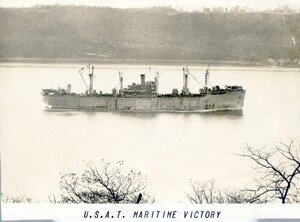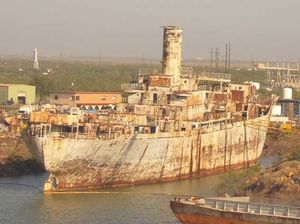SS Maritime Victory

| |
| Career | 100x35px |
|---|---|
| Name: | SS Maritime Victory |
| Builder: | Bethlehem-Fairfield Shipyard, Baltimore |
| Launched: | May 1945 |
| Acquired: | 18 June 1945 |
| Renamed: | USAT Pvt. Frederick C. Murphy, 1950 |
| Fate: | Beaumont Reserve Fleet (until April 2006); awaits scrapping Summer 2006 in Brownsville, Texas |
| General characteristics | |
| Type: | Victory ship |
| Displacement: | 7,607 long tons (7,729 t) |
| Length: | 455 ft (139 m) |
| Beam: | 62 ft (19 m) |
| Draft: | 28 ft 6 in (8.69 m) |
| Propulsion: | Allis-Chalmers cross-compound steam turbine with double reduction gears, 6,000 hp (4,474 kW) at 100 rpm |
| Speed: | 17 knots (31 km/h; 20 mph) |
| Range: | 23,500 mi (37,800 km) |
| Capacity: | 500,000 cubic feet (approx.) |
| Complement: | 62 Merchant Marine and Navy Armed Guard |
| Armament: |
• 1 × 5-inch stern gun • 1 × 3-inch bow anti-aircraft gun • 8 × Oerlikon 20 mm cannon |
SS Maritime Victory, hull number 821, VC2-S-AP2/WSAT was an American Army transport which was saw duty just after World War II. The ship was launched on Tuesday, 22 May 1945. The sponsor was J. Buell Snyder, wife of Congressman Snyder.[1] She was launched from the Bethlehem-Fairfield Shipyards and later delivered on 18 June 1945 then transferred to the Army War Department as an Army Transport. The Maritime Victory was unusual in that as an AP2 vessel the cargo holds were converted for troop berthing (though with reduced cargo carrying ability) and topside cargo handling gear was retained.
Contents
Wartime service
The Maritime Victory was delivered to the USAT as a transport in June 1945. The ship made several crossings carrying troops from the European Theater of Operations, especially between Le Havre and New York. From Le Havre it often left from the area known as the Cigarette Camps.
The ship, having been launched only days after V-E Day was primarily designed to transport troops both to and from Europe. While the main use of the ship was to transport troops, the ship was also used for humanitarian efforts in the immediate post-war time period. The ship made made crossings of the Atlantic. Many of the ships used to transport troops to Europe in the early days of the war were lost or functionally worn out. The Victory ship was newer and faster than the Liberty ships. When it was time to bring troops home the net transfer was mostly in moving troops from Europe to America instead of the other way around.
Some transportation of food and supplies were made in a role as a cargo ship to provide relief to the war torn countries of Europe, especially Germany.
In April 1945, Vice Admiral Howard L. Vickery said the P2 transports "will be our first postwar passenger vessels"[2], but this was not the fate of the Maritime Victory.
Post-war service
In 1947 the ship was transferred to the U.S. Army and subsequently renamed the Pvt. Frederick C. Murphy in 1950 in honor of the Medal of Honor recipient in World War II.
Ready Reserve Fleet and scrapping
The ship was preserved in mothball status at the Beaumont Reserve Fleet in Beaumont, Texas. It was laid up in 1950. From 1983 to about 1990 the Fredrick C. Murphy was used as the fleet utility ship at Beaumont Reserve. In this role some offices were maintained aboard the ship.
The National Park Service's Historic American Engineering Record (HAER) visited the Private Frederick C. Murphy in 2006 to document the ship.[3]
As of 2006, the ship has been removed from inventory of Beaumont Reserve. It is now located at Esco in Brownsville, Texas and awaits scrapping. Scrapping may be complete as soon as September 2006.
Known sailings
| Date | From - To | Purpose |
|---|---|---|
| ? October 1945—26 October 1945 | Marseille, France—New York City | Transport 1,969 troops.[4] |
| ? November 1945—24 November 1945 | Marseille—New York | Transport 1,648 troops[5] |
| ? ??? 1945—18 December 1945 | ???, ???—Newport News, Virginia | Transport 1,436 troops, including 2877th Military Police Battalion.[6] |
| ?? ??? 1946—7 January 1946 | New York—Le Havre, France | Arrived to pick up troops.[7] |
| 7—19 January 1946 | Le Havre—New York | Transport approximately 1,500 members of the 84th Infantry Division (some elements).[7] |
| ? ??? 1946—15 February 1946 | Le Havre—New York | Transport 1,014 troops, including 23rd Base Post Office, 45th Field Hospital, three nurses and five civilians.[8] |
| ?? ??? 1946—22 March 1946 | Southampton, England—New York | Transport 989 troops, including 1196th Engineer Base Depot, 3231st Quartermaster Service Co., 813th Ordnance Base Depot Co., 713th Engineer Depot Co.[9] |
| ? ??? 1946—18 April 1946 | Le Havre—New York | Transport 879 troops, including 123rd Armored Ordnance Maintenance Battalion, 345th Quartermaster Co.[10] |
| 17—26 May 1946 | Bremerhaven, Germany—New York | Transport 102nd Infantry Division (Ozarks), 405th Infantry Regiment. |
| ?? June 1946—25 June 1946 | Le Havre—New York | Transport 1,363 troops.[11] |
| ?? August 1946—4 August 1946 | Bremerhaven—New York | Transport of 1,317 troops.[12] |
| 15 August 1946—?? ??? 1946 | New York—????, ?? | German war prisoners.[13] |
| ?? September 1946—10 September 1946 | Bremerhaven—New York | Transport 1,237 US soldiers back to United States.[14] |
| ?? October 1946—14 October 1946 | Bremerhaven—New York | Transport 1,388 US soldiers back to United States.[15] |
| 22 October 1946—?? October/November 1946 | New York—Livorno, Italy | Transport US Occupation troops to Europe.[16] |
| ?? November 1946—18 November 1946 | Livorno—New York | Transport 1,244 troops.[17] |
| 5 December 1946—?? December 1946 | New York—Bremerhaven | Transport troops.[18] |
| 23 December 1946—2 January 1947 | Bremerhaven—New York | Transport US soldiers back to United States (some US Army Occupation troops). |
| 20 January 1947—?? January/February 1947 | New York—Bremerhaven | Sailing to Europe.[19] |
| ?? ??? 1947—21 February 1947 | Bremerhaven—New York | Transport 832 troops.[20] |
| 10—12 March 1947 | New York—Portland, Maine | To arrive at Portland for loading Maine seed potatoes for shipment to Germany for planting in the American and British Occupied Zones. Sailing was to take place a few days later.[21] |
| 27 March 1947—?? March 1947 | Portland—Germany | Transport of 4,000 tons of Maine seed potatoes.[22] |
References
- ↑ The Evening Standard, "The Local Events of Other Years", p.4, 19 May 1955
- ↑ Galveston Daily News, 28 April 1945
- ↑ "CRM: The Journal of Heritage Stewardship". crmjournal.cr.nps.gov. http://crmjournal.cr.nps.gov/05_report_sub.cfm?issue=Volume%204%20Number%202%20Summer%202007&seq=4. Retrieved 2009-12-05.
- ↑ Chester Times, 26 October 1945
- ↑ Nebraska State Journal, 24 November 1945
- ↑ Moberly-Monitor-Index, 18 December 1945
- ↑ 7.0 7.1 Paris Stars and Stripes, 8 January 1946
- ↑ Moberly-Monitor-Index, 15 February 1946
- ↑ Joplin Globe, 22 March 1946
- ↑ Moberly-Monitor-Index, 15 February 1946 and Joplin Globe, 18 February 1946
- ↑ Moberly Monitor-Index, 25 June 1946
- ↑ Denton Record-Chronicle, 4 August 1946
- ↑ Fulton Patriot, 15 August 1946
- ↑ The Lima News, 10 September 1946
- ↑ The Paris News, 14 October 1946
- ↑ Wisconsin State Journal, 22 October 1946
- ↑ Alton Evening Telegraph, 18 November 1946
- ↑ Wisconsin State Journal, 5 December 1946
- ↑ Wisconsin State Journal, 20 January 1947
- ↑ Moberly Monitor-Index, 21 February 1947
- ↑ Portland Press Herald, 7 March 1947
- ↑ Portland Press Herald, 27 March 1947

